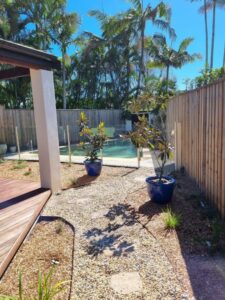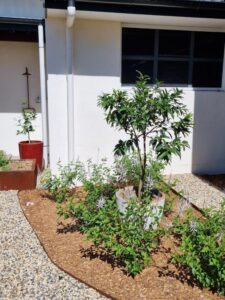
Shrinking backyards – are trees a viable option?
By Patrick Regnault
For those of us who have chosen the rural life, finding the right location and types of trees to plant is our dilemma. For people living in urban and suburban areas it is much more difficult, and sometimes planting a tree is not advised.
Trees need space, above ground of course, and something that is often overlooked is that they required space below ground as well. Root system development can cause grave damage to structures and amenities, ending up costing money to the client and, as we will see, to the professional horticulturist. When not to plant a tree is as important as where and which one to choose.
Urban and suburban gardens are shrinking. Older suburbs had, until the eighties, large blocks of land with a house footprint of 20 to 30% and a maximum of 35 to 40%. This left a large backyard with very good tree cover. From the 90s the lot size changed, becoming smaller whilst the footprint of the house started to become much larger. Ironically, the family size was reduced substantially. I recommend the excellent article by Tony Hall in ArchitectureAU titled “What has happened to the Australian backyard” to understand the loss of garden space.
This shrinkage influences the type of vegetation we can use in our urban and suburban gardens. In some cases, a small tree with a non-invasive root system can be planted if the soil type and services allow it. As professionals, the advice we give our client/s needs to be sound and to the best of our knowledge. If a recommended tree ends up causing structural damage to the buildings or the services, we may find ourselves, sometimes years down the track, burdened with a legal challenge.
Often, small gardens are no more than a paved courtyard with raised borders on the sides. Planting any kind of trees would be madness, yet this is still done. Understanding the root system, and the footprint of the tree, is important. The soil type has an influence on root development. If a tree root cannot go deep enough, due to extreme compaction or any other obstacle, it will have to grow laterally and impede on the structural integrity of buildings.

In my long career I have seen many problems caused by tree roots. Too often caused by thoughtlessness rather than wilfulness. Trees planted directly above plumbing, planted next to the house, planted in a very limited raised bed with little access to natural ground. Those are just a few examples in the long ‘What Not to Do’ list. If the client’s tree wish, or the landscape architect’s choice of tree or location is not suited, it is the responsibility of the landscaper to explain the reasoning behind the need change the design, in writing, and to propose an alternative. Most people will be grateful for the warning and the professionalism.
In cases of limited space, pots are always a possibility. This still involves an understanding of how to care for a plant in a container and its medium, and long-term wellbeing. Where there is restricted but sufficient space to plant a tree there are a selection of trees that can be found. Perhaps a camellia could be used as long as the pH and depth of soil permits. For green shade, a climber with non-invasive roots would work mostly if the design of the support does not look heavy. Large shrubs can be pruned and trained to be tree-like.
Let’s not forget that a garden filled with a diverse selection of shrubs is more attractive, visually and environmentally, than a backyard with a lone tree.
There has been a tendency over the last few decades, as the environmental destruction has accelerated, to project our global fear onto our local environment. Urban forests, mini-forests, fruit forests are not the answer to our visceral anxiety about the future of the planet. Of course, we must act locally and globally but not out of a sense of personal dread but rather out of hope for a better future for all living creatures. We need to remember what is below our feet if we want to design and build a sustainable, long-lasting environment.
Patrick Regnault FAIH RH0062
Interactive Landscapes
E: patrickregnault@hotmail.com
